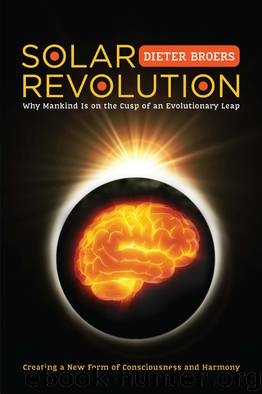Solar Revolution by Dieter Broers

Author:Dieter Broers [Broers, Dieter]
Language: eng
Format: epub
ISBN: 978-1-58394-513-1
Publisher: North Atlantic Books
Published: 2012-09-03T16:00:00+00:00
The list above represents only a handful of the more than twenty-six such items that are known, which raises the following questions: Why is it that the Earth’s physical parameters have virtually no “wiggle room” and are so “ideally” suited for our existence? Can this really just be an incredible coincidence? In the words of Burkhard Heim: “What we refer to as matter is subject to mechanisms that are controlled by the dimensions of mind, which are the origins of everything from Creation up to and including regulation and control of the material world.”
I’d now like to turn my attention to the inhabitants of the cosmos—namely humankind. As you know, an organism is composed of a series of organs, which in turn are composed of various types of tissue that comprise cells. The human organism contains some 250 different cell systems, ten of whose structure and development are currently the subject of scientific research. A living being begins with a fertilized egg cell. Following initial cell division the organism consists of multipotent stem cells, which means that each of these cells has the capacity to generate other cells for the organism. These multipotent stem cells are already differentiated in the embryonic stage from specific stem cells, which as their name suggests can only generate specific types of cells. At birth, human beings have no multipotent stem cells.
When they first come into existence, stem cells can undergo “mitosis,” which means that they can divide. After dividing a certain number of times, these mitotic cells lose this ability and thus enter the “postmitotic” phase.
Biochemist Klaus Bayreuther mainly studied fibroblasts, since they are the most important cells in the human body by virtue of accounting for approximately one-third of the body’s cells.103 Fibroblasts are responsible for roughly 180 cell systems. Over the course of a human life, the proportion of mitotic and postmitotic cells alters.
It is noteworthy that both mitotic and postmitotic cells pass through various phases of differentiation. At the end of these phases—but not on loss of their mitotic capacity—these cells become terminally differentiated end cells, which then die.
Fibroblasts pass through six different stages; three in the mitotic phase, and three in the postmitotic phase. However in any given organism all of these cells are not in the same stage at the same time. Instead, the organism comprises a mixture of cells that are in various differentiation stages, and later-stage cells become increasingly prevalent with age. For example, most of a newborn’s fibroblasts are in phase one, a small fraction are in phase two, and none are in phases three through six, whereas an elderly person mainly has them in phases four through six, none in phase one or two, and only a small fraction in phase three.
The transitions between phases are controlled by proteins that are produced at very specific junctures by the cells themselves via genetic timing mechanisms. In the mitotic phase a molecular cell division timing mechanism comes into play. In rats, a new phase-one fibroblast divides an average of eighteen times before transitioning to a phase-two cell.
Download
This site does not store any files on its server. We only index and link to content provided by other sites. Please contact the content providers to delete copyright contents if any and email us, we'll remove relevant links or contents immediately.
| Administration & Medicine Economics | Allied Health Professions |
| Basic Sciences | Dentistry |
| History | Medical Informatics |
| Medicine | Nursing |
| Pharmacology | Psychology |
| Research | Veterinary Medicine |
Tuesdays with Morrie by Mitch Albom(4688)
Yoga Anatomy by Kaminoff Leslie(4304)
Science and Development of Muscle Hypertrophy by Brad Schoenfeld(4086)
Bodyweight Strength Training: 12 Weeks to Build Muscle and Burn Fat by Jay Cardiello(3913)
Introduction to Kinesiology by Shirl J. Hoffman(3722)
How Music Works by David Byrne(3186)
Sapiens and Homo Deus by Yuval Noah Harari(2987)
The Plant Paradox by Dr. Steven R. Gundry M.D(2545)
Churchill by Paul Johnson(2506)
Insomniac City by Bill Hayes(2496)
Coroner's Journal by Louis Cataldie(2431)
Hashimoto's Protocol by Izabella Wentz PharmD(2330)
The Chimp Paradox by Peters Dr Steve(2296)
The Universe Inside You by Brian Clegg(2096)
Don't Look Behind You by Lois Duncan(2078)
The Immune System Recovery Plan by Susan Blum(2027)
The Hot Zone by Richard Preston(1983)
Endure by Alex Hutchinson(1963)
Woman: An Intimate Geography by Natalie Angier(1881)
